Hookah at the Point of Sale
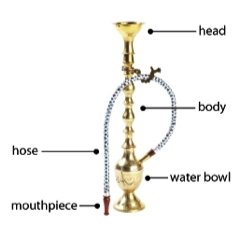 Hookahs (also called narghiles, argilehs, shisha pipes, and hubble-bubbles) are water pipes, consisting of a head, body, water bowl, and hose, used for smoking flavored tobacco or other substances.[6, 4] The shredded tobacco leaf smoked through a hookah, referred to as hookah tobacco, Maassel (Arabic for honeyed) or shisha, is most commonly flavored and sweetened with molasses, honey, or dried fruit and is sold in a wide variety of flavors.[4,5] The device is used by heating tobacco on the head of the pipe with hot charcoal, which, in turn, causes smoke to pass through the water in the water bowl before being inhaled through the hose.[4]
Hookahs (also called narghiles, argilehs, shisha pipes, and hubble-bubbles) are water pipes, consisting of a head, body, water bowl, and hose, used for smoking flavored tobacco or other substances.[6, 4] The shredded tobacco leaf smoked through a hookah, referred to as hookah tobacco, Maassel (Arabic for honeyed) or shisha, is most commonly flavored and sweetened with molasses, honey, or dried fruit and is sold in a wide variety of flavors.[4,5] The device is used by heating tobacco on the head of the pipe with hot charcoal, which, in turn, causes smoke to pass through the water in the water bowl before being inhaled through the hose.[4]
Misconceptions around hookah use and the associated risks are rampant with many individuals, especially youth and young adults, believing hookah to be less addictive, safer, and associated with lower health risks than smoking cigarettes.[5, 17] Since the sweet-smelling smoke from hookahs tends to be less harsh and less irritating on the throat, many wrongly assume that the water bowl the smoke passes through acts as a filtration system, removing toxins and addictive nicotine.[5] However, hookah smoke has been found to be at least as toxic as cigarette smoke.[6] Hookah smoke has more than 82 different toxic agents and carcinogens, and more than one thousand times the quantity of artificial flavoring as cigarettes; the water filters out as little as 3% of those toxins and less than 5% of the nicotine. [15, 7, 14, 16, 6, 35] The true advantage and purpose of the water is simply to cool the smoke, making it easier to smoke higher quantities of tobacco over longer periods of time.[27] As such, typical hookah smoking sessions last approximately one hour or more.[4] The amount of smoke inhaled over that single session typically equates to smoking in excess of 100 cigarettes.[1]
The health consequences of hookah smoking can be debilitating and severe. The nicotine, tar, carcinogens, carbon monoxide, and heavy metals such as arsenic, chromium, cobalt, nickel, and lead in the smoke of both the tobacco and the charcoal have been known to cause lung, bladder, and oral cancer, as well as clogged arteries and heart disease.[4] Hookah smokers may also be at risk of stomach and esophageal cancer, reduced lung functioning, and decreased fertility.[6] Additionally, hookah users are at increased risk of nicotine dependence and are more likely than non-hookah users to start smoking cigarettes.[15, 32] The 2012-2013 National Adult Tobacco Survey found that young adults who smoked hookah, even just intermittently, were 2.3 times more likely to initiate cigarette smoking than non-hookah smokers.[5, 49] A meta-analysis from 2020 found that adolescents and young adults who had ever smoked hookah at baseline had 2.54 times the odds of cigarette smoking initiation and 2.04 times the odds of current cigarette smoking at follow-up, which ranged across the studies from 6 months to 3 years; as well, adolescents and young adults who reported past 30-day hookah use at baseline had 2.46 times the odds of current cigarette smoking at follow-up, which ranged across studies from 6 months to 1 year.[51] It is presumed that those who do become nicotine dependent may make that transition because cigarettes can curb cravings more quickly and are more accessible and simpler to use than traditional hookahs.[32,30] Furthermore, by sharing a mouthpiece with other users, hookah smokers are at increased risk of infectious diseases such as herpes, hepatitis, and tuberculosis.[4] It also should be noted that non-tobacco products, which are often referred to as herbal shisha or herbal fruit molasses, are sold for hookah use and often claim to be safe alternatives to hookah tobacco; smoke from non-tobacco and non-nicotine products, however, still contain toxic agents and increase the risk of serious health problems.[6]
General Trends in Hookah Use
Globally, hookah use is rampant, with an estimated 100 million daily hookah users worldwide.[8] In the United States, hookah use and popularity has grown dramatically in recent years. According to the National Adult Tobacco Survey from 2012-2013, lifetime prevalence of hookah use in American adults over 18 years of age was 12.3%.[43]; the lifetime prevalence of hookah use in Americans between the ages of 12 and 17 is closer to 7.5%, according to the Population Assessment of Tobacco and Health Wave 1 Survey.[5] Though rates of use are highest among urban youth, college students, and young professionals aged 18 to 24, studies have indicated that use is prevalent across gender, race, age, locality, and socioeconomic status as well.[8, 1, 7, 15] These trends have corresponded with a boom in the quantity of hookah smoking establishments, which tend to be clustered in large metropolitan areas, within 3-9 miles of college campuses, and in localities with large Middle Eastern and young adult populations.[4] As of 2015, two-thirds of states had hookah bars and cafés, totaling 1,500 known hookah establishments, though it can be assumed that this number has increased over the years.[4, 5, 7] Greater numbers of hookah establishments and higher rates of use have been found in areas with strong tobacco control legislation and declining rates of cigarette use. [18] Across all demographics, hookah use is associated with access to hookah bars, and greater frequency of use is associated with owning a waterpipe and initiating hookah use at a younger age.[8, 7]
Youth and Young Adult Hookah Use
Prevalence
Hookah smoking is more popular among youth and young adults than older adults.[5] In fact, young adults aged 18 to 24 account for 55% of all hookah smokers in the United States.[32] College students have particularly high rates of use, and attending college has been found to be positively associated with hookah use, as well as with dual cigarette and hookah use.[8] Surveys of US college students have found that approximately 40% of students have ever smoked hookah and approximately 10% have used hookah in the last 30 days.[8, 15] Individuals, on average, initiate hookah smoking at age 19, an age slightly higher than that of cigarette initiation.[12] Correspondingly, both the highest prevalence of hookah tobacco smoking and greatest risk of initiation is amongst college freshman.[12]
Rates of hookah use among middle and high schoolers is equally concerning. The 2016 National Youth Tobacco Survey found that 4.8% of high schoolers, approximately 700,000 students, reported smoking hookah within the past 30 days and the 2016 Monitoring the Future Survey found that 13% of high school seniors reported smoking hookah within the past year.[5] The Population Assessment of Tobacco and Health Wave 1 survey of 13,000 individuals aged 12 to 17 found that 7.5% of youth respondents had a history of ever smoking hookah.[5] Ever use was similar between males and females, but found to be higher among LGBTQ youth than heterosexual youth.[5] Among these middle and high schoolers, less than 1% smoked hookah daily.[5]
Reasons for Youth and Young Adult Hookah Use
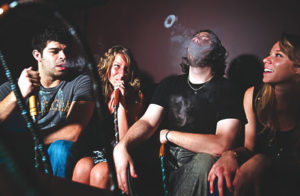 Young adults and youth report a wide number of reasons for initiating and continuing hookah use. A major driver is the belief that hookah smoking is safer than cigarettes.[7] In studies of college students, half of participants believed hookah smoking to be less addictive than cigarette smoking and nearly 100% of participants believed they could quit smoking hookah at any time; many also did not associate their hookah use with the tobacco industry.[8] A survey of students in a slightly younger demographic, aged 12 to 17, found that 61% believed hookah smoking to be less harmful than cigarette smoking.[5] In addition to perceived safety, youth and young adults also tend to describe the social and entertaining aspects of hookah smoking as a major motivator for initiation and use. In the same survey of 12 to 17 year-olds, 80% reported smoking hookah because they “like socializing while using [hookahs].”[5] Seen as a fun activity to be done in the company of friends, hookah smoking is not stigmatized like smoking other tobacco products is, and rather is deemed cool and socially acceptable by peers.[10] This type of social and peer encouragement and use can have a strong effect on smoking initiation, as is evidenced by a study which found that 98% of college students initiated hookah smoking while in the presence of friends.[14]
Young adults and youth report a wide number of reasons for initiating and continuing hookah use. A major driver is the belief that hookah smoking is safer than cigarettes.[7] In studies of college students, half of participants believed hookah smoking to be less addictive than cigarette smoking and nearly 100% of participants believed they could quit smoking hookah at any time; many also did not associate their hookah use with the tobacco industry.[8] A survey of students in a slightly younger demographic, aged 12 to 17, found that 61% believed hookah smoking to be less harmful than cigarette smoking.[5] In addition to perceived safety, youth and young adults also tend to describe the social and entertaining aspects of hookah smoking as a major motivator for initiation and use. In the same survey of 12 to 17 year-olds, 80% reported smoking hookah because they “like socializing while using [hookahs].”[5] Seen as a fun activity to be done in the company of friends, hookah smoking is not stigmatized like smoking other tobacco products is, and rather is deemed cool and socially acceptable by peers.[10] This type of social and peer encouragement and use can have a strong effect on smoking initiation, as is evidenced by a study which found that 98% of college students initiated hookah smoking while in the presence of friends.[14]
Two other frequently mentioned reasons for hookah use were the ability to sample and mix a wide variety of flavors which would produce a pleasant taste and smell, and the affordability of hookah tobacco in comparison to cigarettes.[5,13] Some young adults also noted ease of access as a driver of use, specifically mentioning the legality of use, the age limit, the convenience of online purchasing and the density of hookah establishments and retailers as being contributing factors.[31] Many other reasons for youth and young adult hookah use were mentioned across studies including, but not limited to, relaxation, boredom, curiosity, novelty, indoor use, cultural acceptability, and peer and family encouragement.[5, 31] An assessment of young adults who had never smoked hookah found that the appealing flavors and the social aspect of hookah smoking were the greatest temptations to start smoking hookah.[26] On the other hand, those who discontinued smoking hookah mentioned doing so as a result of cost, disinterest, anti-tobacco attitude and social reasons.[26]
Hookah Establishment and Hookah Tobacco Industry Marketing Strategies at the Point-of-Sale and Point-of-Consumption
Studies suggest that young adults who would otherwise not use tobacco (as determined by their strong anti-tobacco industry attitudes and low receptivity to tobacco marketing) are becoming attracted to smoking hookah and visiting hookah establishments.[8] This same population may also not associate their hookah use with tobacco use and therefore may not be receptive to current anti-tobacco messaging.[8] For this reason, it is of critical importance to analyze and evaluate the point-of-sale and point-of-consumption marketing strategies used by hookah establishments and the hookah tobacco industry, as well as the various other ways in which youth are enticed into smoking hookah. Understanding this landscape can help direct and motivate policy change.
Density and Location of Hookah Establishments

A greater density of tobacco retailers has been found to be associated with higher levels of smoking.[23] While a similar study has not yet been conducted in regard to hookah establishments, access to hookah bars has been found to be associated with hookah use and hookah smoking initiation.[8, 14] Studies of college students have shown that 60% of student hookah smokers initiated use at a hookah establishment and over half smoke hookah more frequently at a hookah establishment than any other location.[14, 26] Visiting a hookah establishment is so common in this population of college students that 85% of ever hookah smokers had been to a hookah establishment at least once in their lifetime.[14]
The location of hookah establishments targets this young adult population in particular. A study of 1,454 colleges in the United States found that 38% had one or more hookah establishments within 3 miles of campus and 50% had one or more hookah establishments within 9 miles of campus.[23] Moreover, approximately 75% of these hookah establishments had another hookah establishment less than 3 miles away, a telling sign of how clustered these establishments are around young adult-centric locations.[23] These statistics prove troubling as studies have found that current hookah use is associated with having a hookah establishment within 10 miles of campus.[14, 30] Setting up shop close to campus is a known and marketed tactic in the industry; some websites that provide advice on opening hookah establishments specifically recommend doing so in close proximity to campuses in order to easily attract curious college students, especially those under legal drinking age who are looking for an alternate form of nightlife. [12, 23]. While these findings are concerning, it is important to keep in mind as regulatory measures are considered that public universities and campuses with smoke-free policies were less likely to have hookah establishments in the immediate vicinity (within 3 miles) of campus.[23]
Hookah Establishments: Point-of-Consumption and Point-of-Sale Marketing Strategies Used on Premises and Websites of Establishments
Hookah establishments, which are often advertised as bars, cafés, and lounges, are frequented by young adults, especially college students, as a place to smoke hookah, socialize, and even study. A report on college students found that 85% of ever hookah smokers had visited a hookah establishment at least once, and 21% of students who had never smoked hookah had visited an establishment at least once as well.[14] Visitors tended to go on weekend evenings and spent an average of 105 minutes at the establishment.[14] At these types of establishments, hookah is most often prepared by staff, meaning patrons rarely come in contact with tobacco in its packaged form and thereby any associated warnings that may be on the packaging of hookah tobacco, waterpipes, or accessories.[19,20] Since young adults frequent these establishments often and spend great lengths of time on premise, it is important to examine, in addition to marketing strategies at the point-of-sale, the industry tactics employed at the point-of-consumption.[19,20]
 College students, whether they had ever or never smoked hookah, discussed becoming aware of hookah lounges and cafés through friends, media advertisements, or passing by an establishment.[14] Beyond these methods, many other tactics are utilized by hookah establishments to promote their venue and lure in customers. Establishments usually aim to create either a pleasant and relaxing environment, with comfortable seating, tables for computer use and free Wifi, or a fun and upbeat environment with drinks, food, and events.[20, 14] Events may include belly dancing, live music or DJs, poker nights, movie showings, and broadcastings of sporting or other widely publicized events.[20, 24, 14] Some hookah bars serve and even cross-promote with alcohol, while others simply serve non-alcoholic beverages like tea and coffee to create a more sophisticated café environment and to cater to the under 21 crowd.[5, 14, 20] In addition to serving hookah, establishments may also retail waterpipes and individually packaged hookah tobacco on premise.[14] Young adults report that the benefits and facilitators to spending time at a hookah establishment are the ability to socialize with friends, the experience of being in a fun and relaxing environment, the chance to meet people, and the location of establishments in close proximity to home or school.[14]
College students, whether they had ever or never smoked hookah, discussed becoming aware of hookah lounges and cafés through friends, media advertisements, or passing by an establishment.[14] Beyond these methods, many other tactics are utilized by hookah establishments to promote their venue and lure in customers. Establishments usually aim to create either a pleasant and relaxing environment, with comfortable seating, tables for computer use and free Wifi, or a fun and upbeat environment with drinks, food, and events.[20, 14] Events may include belly dancing, live music or DJs, poker nights, movie showings, and broadcastings of sporting or other widely publicized events.[20, 24, 14] Some hookah bars serve and even cross-promote with alcohol, while others simply serve non-alcoholic beverages like tea and coffee to create a more sophisticated café environment and to cater to the under 21 crowd.[5, 14, 20] In addition to serving hookah, establishments may also retail waterpipes and individually packaged hookah tobacco on premise.[14] Young adults report that the benefits and facilitators to spending time at a hookah establishment are the ability to socialize with friends, the experience of being in a fun and relaxing environment, the chance to meet people, and the location of establishments in close proximity to home or school.[14]
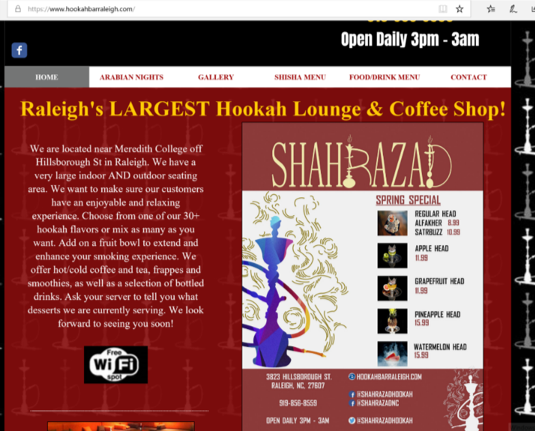
Other than conveniently locating near campuses and using word-of-mouth advertising, hookah establishments often advertise themselves online, in newspapers geared towards young adults, and in student publications and coupon booklets.[13, 14, 24] Through these avenues, they often heavily promote their establishments, encourage hookah use, and provide financial incentives to make smoking hookah more affordable to students on a budget. An assessment of 144 hookah establishment websites from across the United States found that 79% advertised food sales, 47% mentioned being a full-service restaurant, 41% advertised serving alcohol, and 37% offered either dancing or live music as entertainment at the venue.[24] Only 1% of websites had an age requirement to enter and view the website, though none required an actual verification of age.[24] Only 1 of the 144 websites had a warning of the health effects of smoking tobacco on the first page and only 6 had a tobacco-related warning anywhere on the website.[24] In fact, only a little over half the websites had any mention of tobacco on any page and 16% of sites directly suggested that hookah smoking was safer than cigarette smoking.[24] Deemphasizing tobacco like this while also promoting hookah establishments as social and fun environments may influence perceptions of hookah smoking as harmless and safe.[24] In addition to the above, 72% of sites mentioned the variety of flavors available at their establishment and many establishments used the first page to highlight special deals, discounts, and events.[24,40]
Price discounts and promotions, while regularly mentioned on websites, were also heavily promoted in print advertisements and on premise and were more often available at independent, rather than franchise, hookah businesses.[13, 14,22] A study on hookah establishment advertisements in young adult newspapers in four cities found frequent mention of discounted smoking sessions, like hookah bar happy hours, and financial incentives, like coupons, sweepstakes, discounts, and specials.[13] Many of these advertisements specifically targeted college students; for instance, some establishments mentioned only accepting coupons with a student ID and others included the name of the college directly on the advertisement [e.g. “UCF’s oldest smoke shop”].[13] Overall, hookah establishments utilized similar tactics for newspaper advertisements as for their websites. Close to half of the ads in the newspapers had no mention of tobacco and many promoted hookah smoking as a harm-reduction alternative.[13] Print ads also tended to highlight the availability of food and entertainment at the venue and promoted the establishments as relaxing, social, and luxurious environments.[13] These types of advertisements, discount promotions, and coupons have also been found in university newspapers as well as coupon booklets handed out to students on campus.[40]
Hookah establishments are dangerous in that they entice young adults to enter an area in which hookah smoking initiation and continued use is encouraged.[8] Furthermore, they lure hookah smokers, and even non-smokers, into environments where extensive amounts of time are spent being exposed to secondhand smoke from both the charcoal and the exhaled smoke from users.[5] The air in hookah establishments has been found to have significantly higher concentrations of carbon monoxide and particulate matter than in those establishments that allow cigarette smoking.[12, 15] Dealing with smoke has been named a barrier to visiting hookah establishments. [14] Other barriers mentioned by young adults to visiting hookah establishments include the price of hookah [which is generally higher in metropolitan areas], age limits, having to wait in line to get in and having to drive to a lounge.[14, 31] When thinking about imposing regulations, these impediments are important to keep in mind.
Hookah Tobacco Flavors
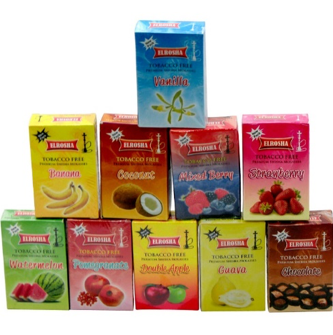 Providing hookah tobacco in an assortment of kid-friendly flavors is a strategy used by the industry to attract youth and young adults. The sweetened tobacco, sold in colorfully illustrated packaging, comes in a plethora of tasty flavors like watermelon, chocolate, caramel, and tutti fruitti, and helps blunt the harshness of the smoke.[14, 32] In the United States, almost the entire retailer market and nearly all sales from establishments stem from flavored hookah products.[22] Studies in the United States have found that approximately 90% of youth and young adults first smoked, and currently smoke, flavored hookah tobacco.[5] As well, the majority of young adults who had ever smoked hookah had only ever smoked flavored hookah tobacco.[14] A research experiment with college students examined how flavor options, nicotine content, price and the presence of health warnings on hookah establishment menus influenced selection of products.[38] Their findings determined that flavor options increased demand for hookah smoking and that the large majority of students selected a hookah tobacco product based on flavor, rather than price or nicotine content.[38] Participants were significantly more likely to choose flavored products over non-flavored products, with a stronger effect size found in women and non-cigarette smokers.[38] Women were also more likely to select products with cryptic flavor names, like Blue Mist or Pirate’s Cove;[38] while used to intrigue and lure customers, these ambiguous flavor labels are also used as an industry ploy to circumvent flavor bans and regulations.[44] Important to note from this study as well – receiving a menu with a health warning was associated with not selecting any options, or opting-out, from the hookah menu completely.[38] Another study found that when people smoked flavored hookah, they reporting enjoying the experience more and smoked for longer amounts of time than those who smoked non-flavored hookah. [50]
Providing hookah tobacco in an assortment of kid-friendly flavors is a strategy used by the industry to attract youth and young adults. The sweetened tobacco, sold in colorfully illustrated packaging, comes in a plethora of tasty flavors like watermelon, chocolate, caramel, and tutti fruitti, and helps blunt the harshness of the smoke.[14, 32] In the United States, almost the entire retailer market and nearly all sales from establishments stem from flavored hookah products.[22] Studies in the United States have found that approximately 90% of youth and young adults first smoked, and currently smoke, flavored hookah tobacco.[5] As well, the majority of young adults who had ever smoked hookah had only ever smoked flavored hookah tobacco.[14] A research experiment with college students examined how flavor options, nicotine content, price and the presence of health warnings on hookah establishment menus influenced selection of products.[38] Their findings determined that flavor options increased demand for hookah smoking and that the large majority of students selected a hookah tobacco product based on flavor, rather than price or nicotine content.[38] Participants were significantly more likely to choose flavored products over non-flavored products, with a stronger effect size found in women and non-cigarette smokers.[38] Women were also more likely to select products with cryptic flavor names, like Blue Mist or Pirate’s Cove;[38] while used to intrigue and lure customers, these ambiguous flavor labels are also used as an industry ploy to circumvent flavor bans and regulations.[44] Important to note from this study as well – receiving a menu with a health warning was associated with not selecting any options, or opting-out, from the hookah menu completely.[38] Another study found that when people smoked flavored hookah, they reporting enjoying the experience more and smoked for longer amounts of time than those who smoked non-flavored hookah. [50]
Hookah Tobacco Packaging and Advertising at the Point-of-Sale
Hookah tobacco is packaged and sold online and at retail outlets in ways that attract and influence use, especially among younger consumers.[5] Assessments made at two international hookah trade exhibitions found common themes on the advertising materials used by retailers and directly on the packages of hookah tobacco. Advertisements predominantly had positive descriptive elements in regard to flavor, smell, taste, and safety, and nearly all touted hookah tobacco as a healthier alternative (though often failed to mention what exactly hookah tobacco was a healthier alternative to).[9] Packaging tended to have misleading descriptors and no products fully complied with the health warning guidelines laid out in the World Health Organization’s Framework Convention on Tobacco Control Article 11 on “Packaging and Labeling of Tobacco Products”. In brief, although each product contained at least one health warning, none met all the guidelines in terms of size and location of the warning on the package, coloring of the warning, or pictorially displaying the warning.[37] Online retailers similarly failed to display health warnings or refer to hookah tobacco as being a tobacco product on their websites.[12] Additionally, hookah accessories and hookah-specific charcoal tended to have misleading safety claims that were not backed by science.[37, 30, 34]
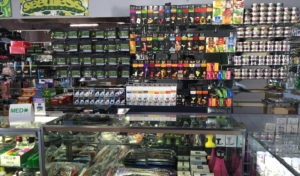 Understanding how individuals respond to packaging like this can provide important insight. A qualitative study from London, England found mixed opinions in regard to stylistic elements of packaging.[19] While some participants stated colorful packaging seemed “unsophisticated and unattractive”, many noted that the packaging was eye-catching and alluring, encouraged their own use, and could easily and understandably be confused by children as candy.[19] When eliciting feedback on different packaging, the researchers found that participants had greater negative responses to packages that were plain and had large health warnings.[19] Additionally, it was found that packaging hookah tobacco in a fashion similar to cigarettes could be a promising tactic to discourage purchase and use; since the participants regularly associated cigarettes with being harmful, seeing hookah tobacco in a cigarette-like package increased the participants’ association between hookah tobacco and negative health consequences.[19]
Understanding how individuals respond to packaging like this can provide important insight. A qualitative study from London, England found mixed opinions in regard to stylistic elements of packaging.[19] While some participants stated colorful packaging seemed “unsophisticated and unattractive”, many noted that the packaging was eye-catching and alluring, encouraged their own use, and could easily and understandably be confused by children as candy.[19] When eliciting feedback on different packaging, the researchers found that participants had greater negative responses to packages that were plain and had large health warnings.[19] Additionally, it was found that packaging hookah tobacco in a fashion similar to cigarettes could be a promising tactic to discourage purchase and use; since the participants regularly associated cigarettes with being harmful, seeing hookah tobacco in a cigarette-like package increased the participants’ association between hookah tobacco and negative health consequences.[19]
While assessing hookah tobacco packaging is absolutely necessary, it is important to note that consumers of hookah tobacco at hookah establishments do not often come into contact with the tobacco package itself as staff generally prepare the hookah out of view of customers.[19] Thereby, a large portion of hookah smokers never see the point-of-sale strategies mentioned above. Health warnings may therefore need to be focused at the point-of-consumption to be most effective.[19]
Hookah Tobacco Brand Marketing on Social Media
Social media platforms are often used by the hookah tobacco industry to market their products to target audiences, such as youth and young adults, in a largely unregulated way. Though many platforms, such as Facebook, have clear policies prohibiting tobacco companies from promoting and selling tobacco products on their sites, automated screening methods used to flag pages with infringements of these policies are often ineffective, resulting in a large number of companies continuing to promote their tobacco products on social media sites with wide reach.[39] One study analyzed 388 tobacco brand Facebook pages. As background, Facebook has 5.8 million teenage users with 65% reporting daily use.[39] The study found 46 Facebook pages for hookah tobacco brands, of which 27 were directly sponsored by the brand (determined by a direct Facebook link on the brand’s website) .[39] Hookah tobacco had the highest prevalence of brand-sponsored pages among all tobacco products. Further analysis of these brand-sponsored hookah tobacco pages found that 41% had direct-to-consumer purchase links and 48% had sales promotions including special sales for holidays, coupons, and discounts. Additionally, only 22% had the required age gate to access the page, allowing underage users to view the content, and 100% displayed tobacco product imagery. All of the above advertising and promotional strategies are in violation of Facebook policy. In addition, nearly every brand-sponsored page, across all tobacco products, posted sponsored events, memes, and contests to attract followers, likes, and visits to the page. These findings prove to be concerning as one study found that young adults who engaged with online tobacco marketing had “higher incidence of initiation, increased frequency of use, progression to poly-product use, and lower incidence of cessation at follow-up” than those who did not engage in online tobacco marketing.[36]
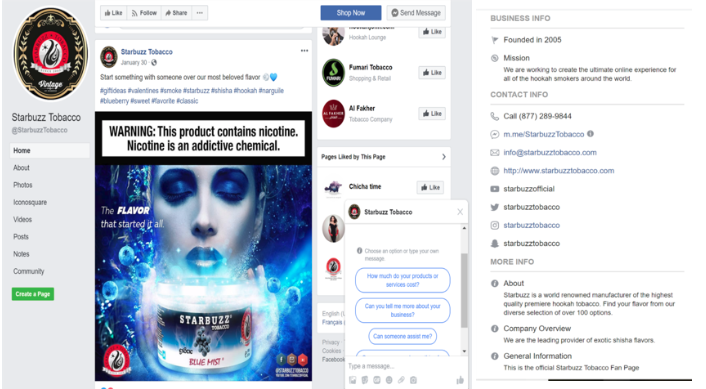
Starbuzz Tobacco, a hookah tobacco brand, directly sponsors this page in which they promote flavored hookah tobacco products and new accessories, provide a “Shop Now” button, answer consumer questions, and link to their website as well as their official Snapchat, Twitter, Instagram, and YouTube platforms.
Depictions of Hookah Smoking and Use on Social Media
Studies have found that exposure to depictions and talk of peer tobacco use on social media sites may be a powerful influencer of experimentation with tobacco products and is a future predictor of tobacco use in young adults.[11, 21] Multiple studies have looked at depictions and talk of hookah, hookah tobacco, and hookah smoking on social media platforms such as Twitter, Instagram, Facebook, and Pinterest. While detailed information can be found in the journal articles listed below, important takeaways are as follows.
Pro-hookah messages are extremely prevalent with the number of pro-hookah posts heavily outweighing the number of posts that are anti-hookah or discuss the harms of hookah smoking; these largely unregulated posts portray hookah use and smoking as normative behaviors and allow underage individuals to easily see endorsements from both their peers and influencers. As such, youth and young adults are receiving messages about hookah smoking being less harmful and less addicting and hookah use being fun and desirable, not just from the industry, but from those in their social and virtual networks as well.
Additional information on depictions of hookah smoking and use on social media:
- “Hookah-related Twitter chatter: A content analysis”
- “#Hookahlife: The rise of waterpipe promotion on Instagram”
- “A comparison of cigarette- and hookah-related videos on YouTube”
- “An exploration of online behaviors and social media use among hookah and electronic cigarette users”
Current Regulations, Guidelines, and Gaps
International Guidelines
The World Health Organization Framework Convention on Tobacco Control is an evidenced-based treaty that covers over 90% of the global population. While not ratified by the United States, the treaty sets a global framework for tobacco control and “stresses the importance of education of harm, clear package content labeling, and prohibition of waterpipe tobacco smoking in areas where cigarettes are banned.”[18] Article 11 provides specific packaging and labelling guidelines for tobacco products.[37]
Federal Regulations
The Family Smoking Prevention and Tobacco Control Act of 2009 granted the U.S. Food and Drug Administration (FDA) authority to regulate the manufacturing, distribution, and marketing of cigarettes, cigarette tobacco, roll-your-own tobacco and smokeless tobacco products. In 2016, the FDA was granted regulatory authority to all tobacco products including hookah tobacco, pipe tobacco, cigars, and e-cigarettes. However, hookah tobacco products on the market as of August 8, 2016 did not have to submit tobacco product review applications until 2021.[41]
Current federal regulations include the following:
- Retailers must check photo ID for everyone under the age of 27 who attempts to purchase hookah tobacco.
- Retailers can only sell hookah tobacco to those age 18 and older (retailers must also follow state and local hookah tobacco laws, including those that are more restrictive).
- Hookah tobacco cannot be sold in vending machines unless these machines are located in adult-only establishments.
- Retailers cannot provide free samples including any components or parts
- Hookah tobacco cannot be sold or distributed without a health warning statement on the addictiveness of nicotine on the package (tobacco manufactured before August 10, 2018 can still be sold in original packaging).
- Retailers cannot display advertisements for hookah tobacco without a health warning statement on the addictiveness of tobacco.
- Hookah tobacco manufacturers must register with the FDA; report product and ingredient listings; have new products reviewed by the FDA; only make claims of reduced risk and public health benefit if confirmed by scientific evidence; and not distribute free samples.[18]
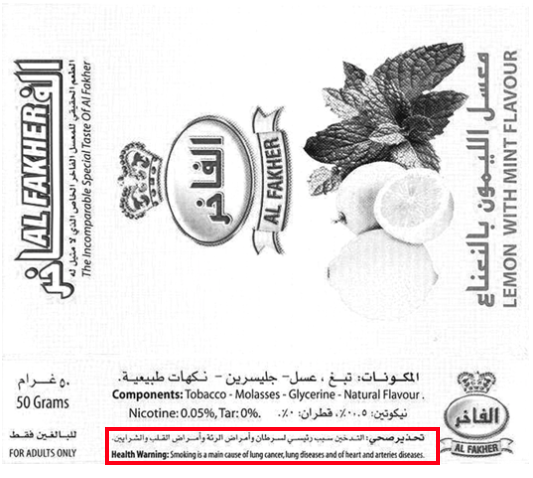
Federal Regulatory Loopholes and Gaps
Currently there are no prohibitions on retail of flavored hookah tobacco nor is there a federal excise tax on hookah tobacco.[4, 15] Additionally, many hookah establishments are exempt from smoke-free air laws.[4] Hookah lounges often gain exemption from these laws by claiming to be tobacco product shops or tobacco retail establishments.[4, 7] Some of these smoke-free air laws also only apply to “tobacco products”, thereby allowing non-tobacco hookah products to continue to be smoked indoors and in public places.[4] A study from 2015 found smoke-free law exemptions for hookah establishments in 24 states and loopholes exempting establishments with a fixed percentage of tobacco product sales in 14 other states.[35] At the federal level, there is no preemption in regard to regulating advertising and sale of non-cigarette tobacco products, meaning states and local authorities have the power to regulate hookah tobacco promotion and advertising and warn consumers of the dangers of smoking hookah.[4]
State-Level Regulation Examples
Some states have places limits on the sale of flavored hookah tobacco, though exemptions remain. See the Public Health Law Center’s resource “Keeping Hookah Tobacco in Flavor Restrictions: Why It’s Important for Health Equity” for more on this topic. Other states have taken action to limit the type of establishments that can serve hookah. Specifically:
- Massachusetts: In December 2019, Massachusetts became the first state to prohibit the retail sale of all flavored tobacco products, including hookah. However, it includes an exemption for flavored tobacco products sold at licensed smoking bars (like hookah lounges) for onsite consumption.
- California: California SB 793, passed in August 2020 and effective January 2021 prohibits most flavored tobacco products, but exempts hookah, along with loose leaf tobacco and premium cigars. A previously proposed bill aimed at prohibiting the sale of flavored tobacco products was withdrawn after “hostile amendments” were added to the bill that would have exempted tobacco products, including hookah tobacco, patented before 2000.[28, 29]
- Illinois: Hookah establishments must obtain more than 80% of their gross revenue from the sale of tobacco products, and not sell food or alcohol, in order to be deemed a retail tobacco store exempt from smoke-free air laws.[27]
- Michigan: In order to serve hookah on premise, hookah establishments must be deemed a “tobacco specialty store”, in which case the establishments cannot serve food or alcohol.[7]
- North Carolina: Hookah establishments are no longer allowed to serve food or alcohol.[7]
Local-Level Regulation Examples
- New York, NY:
- An ordinance was passed prohibiting the sale of all flavored [other than menthol, mint, and wintergreen] non-cigarette tobacco products, including hookah tobacco.[4] The industry initially argued that manufacturing standards were being imposed on their products but the ordinance passed, allowing state and local authorities to regulate the sale and distribution of non-cigarette tobacco products.[4]
- New York City law also requires all hookah establishments to have a permit, only sell non-tobacco hookah products, and display warnings about the health risks of hookah smoking.[42]
- Additionally, retailers cannot sell or serve hookah tobacco and non-tobacco hookah products to those under 21 and those under 21 cannot enter hookah establishments.[42]
- Providence, RI: Sales of flavored hookah tobacco have been banned.[4]
Many states and localities have taken other actions to address hookah use in their community. Maine, Boston, and Philadelphia have removed exemptions from their smoke-free air laws that previously allowed hookah smoking indoors.[7, 15] Philadelphia has also prohibited hookah smoking in outdoor areas that are adjacent to smoke-free areas.[15] As well, the city of York in Pennsylvania has banned the use of tobacco products, including hookah tobacco, on city-owned property as well as designated public spaces, such as parks, playgrounds, and monuments.[15] Philadelphia has also imposed a $0.36/oz excise tax on hookah tobacco.[15]
Point of Sale Policy Options
- Ban the sale of flavored hookah tobacco [2, 7, 20, 22, 25, 44]
- Prohibit the sale of flavored hookah tobacco products, including ambiguously named products that still have flavor profiles and aromas (e.g. Blue Mist, Pirate’s Cove)
- Restrict the sale of flavored hookah tobacco to certain locations
- Prohibit the sale of flavored hookah tobacco in establishments within a set distance from youth-centered locations
Banning flavors could reduce hookah smoking initiation and continued use, especially in youth and young adults.[20] However, this could be met with a lot of industry pushback since the market is heavily dominated by flavored products [22]
- Require health warning signage at hookah establishments[1, 16, 18, 34]
- Include on signage that hookah tobacco has nicotine, is addictive, and has harms associated with use
- In addition to signage, warnings can and should be included on establishment menus as well as on the hookahs and hookah accessories provided to patrons
This policy would reach target audiences at the point-of-consumption, combat misconceptions and misinformation about the harms of hookah use, and reduce the risk of health consequences [1] Youth cite a lack in health warnings as a reason they believe hookah to be safer than other tobacco products.[5]
- Require health warning signage in retail environments that sell hookah tobacco, hookahs, and hookah accessories.
- Set stricter requirements for health warnings on packaging for hookah tobacco, hookahs, and accompanying accessories[16, 18, 30]
- Health warnings that rotate, cover more than 30% of the primary display area, include wording that is large and clear, and contain pictorial warnings may be more effective [30]
- Establish licenses for hookah retailers and hookah establishments
Licensing systems can serve as a regulatory platform to enforce any sales restrictions on hookah tobacco. As well, licensing systems help create comprehensive lists of hookah retailers and establishments, which can be used to organize site inspections and track compliance. Learn more about licensing here.
- Utilize zoning laws to regulate the density and location of hookah establishments and retailers, especially near campuses [7, 12, 14, 34]
Reducing the number and regulating the location of hookah establishments and retailers will make it harder for young adults in particular to access hookah tobacco. Young adults have specifically mentioned driving to hookah establishments and waiting in line to enter hookah establishments as barriers, suggesting that imposing such laws could counter young adult hookah use at these types of venues.[14]
Those under 21 often utilize hookah establishments as alternatives to bars. Raising the minimum age to purchase hookah tobacco and enter hookah establishments could reduce hookah use among those under 21 [20]
- Prohibit price discounts and coupon redemption at retail environments and hookah establishments [22]
- Ban pictures that could lure youth such as those of fruit and candy on hookah tobacco packaging[18, 19]
- Ban pictures that could lure youth such as those of fruit and candy on hookah tobacco packaging
- Prohibit duty-free hookah tobacco sales[30]
- Prohibit unbacked safety claims marketed by non-tobacco hookah products [30]
- Be sure that all policies have clear wording that directly define hookah as a tobacco product [7, 15, 20]
Regulations on cleaning hookah devices at hookah establishments are lacking. As a result, mouth pieces and water bowls of hookahs become easily contaminated and become modes of transmission for a variety of bacterial and viral illnesses and diseases. [18]
- Expand restrictions on online purchasing and shipping of all tobacco products. [25]
Additional Policy Options and Next Steps
Beyond point-of-sale policies, other regulatory actions can be taken to reduce hookah use, especially in young adult and youth populations. Increasing excise taxes, closing smoke-free air law loopholes, and more stringently regulating hookah tobacco promotion and advertising on product packaging and social media platforms, as well as at points of sale and consumption, may effectively reduce young adult and youth use and combat the sentiment that smoking hookah is a safer and more normative behavior than smoking other tobacco products [2, 7, 12, 14, 16, 20, 21, 22, 25, 30, 34, 47, 48]. Likewise, educational and program-based interventions that highlight the misconceptions and dangers of hookah smoking and provide support and resources for those wanting to reduce or stop their hookah use should be funded and implemented on college campuses and in communities across the United States.[1, 8, 16, 30, 32]
Additional Resources
- Public Health Law Center’s
- CDC’s fact sheet on hookah
- American Lung Association’s Hookah Policy Brief and Facts about Hookah


